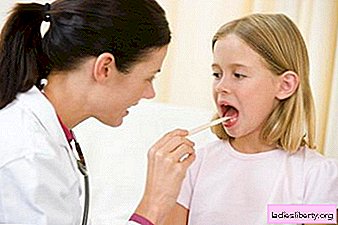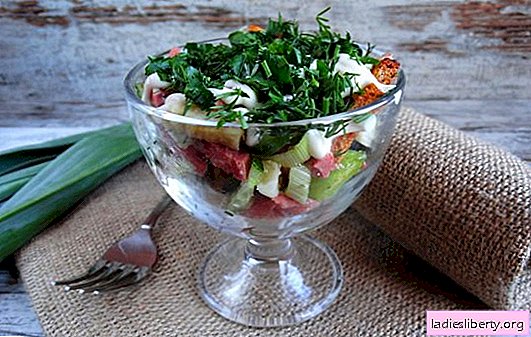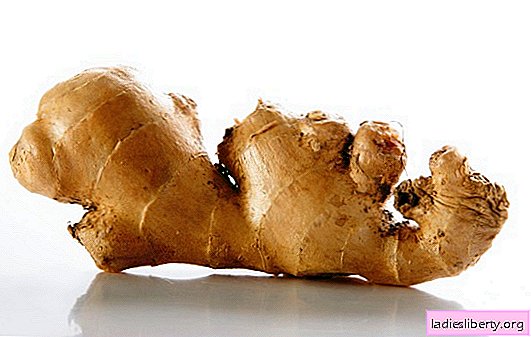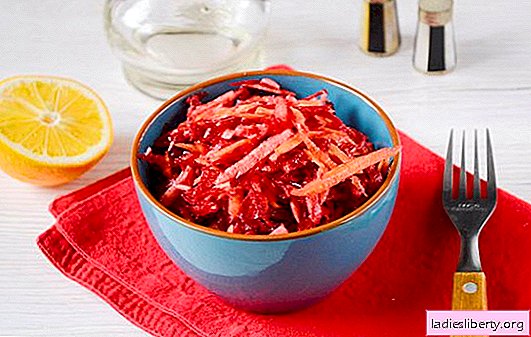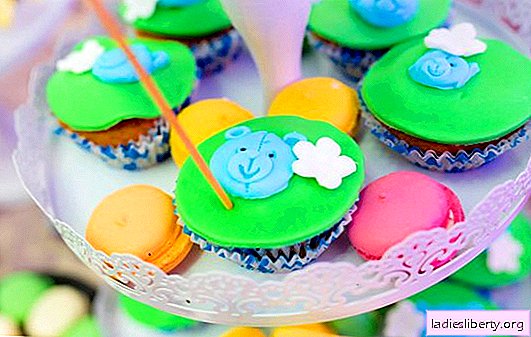
Bright and colorful glaze that adorns the surface of confectionery immediately causes a desire to bite off a piece, to feel some unusual taste. But often a red or yellow jewelry is an ordinary sweet coating, without a promising aroma.
If the glaze has a lemon color, then its taste should meet expectations, so that the sweetness does not cause disappointment with a deceptive appearance. Is it unfair? Fortunately, achieving such results is not at all difficult.
Cupcake Frosting - Basic Technological Principles
Traditional types of gingerbread icing are now used not only for coating gingerbread, but for other types of baking. Gingerbread icing is prepared on the basis of sugar and egg white, with the addition of flavorings and natural food colors. There are three ways to prepare it, which are described in detail below in recipes.
But the confectioners, since the invention of the protein glaze, have not sat idly by. During this time, new culinary inventions appeared, and in many respects they were promoted by simple housewives, whose names remained unknown. Chocolate and milk glaze, fruit and caramel appeared. There are some nuances in the technology of its preparation, but the basis of all recipes is thick sugar syrup.
The principle is this: sugar is combined with a liquid. First, it dissolves in it, and then the liquid leaves, and sugar crystals form strong "threads", connecting with each other. Bright colors are embedded in this structure - food pigments, tasty aromas. But frozen caramel cannot be applied to the surface of a cake or a gingerbread. She is brittle and tough. To give plasticity while working with glaze, proteins and fats are introduced into its base: milk or egg.
Further, in the preparation of glaze, only individual strokes are used that do not have fundamental significance and do not affect its basic properties.
In fact, the color of the glaze is the easiest in the technology of its preparation. It can be achieved with food colors of natural origin. According to the color of the glaze, the fruit component is selected. This is the easiest technological stage.
Please note that frozen glaze can have a matte and glossy surface - and this is already much more interesting!
The texture of the sweet coating may have a different texture - crispy, oily, stretching. This criterion depends on the composition of the ingredients.
Finally, what needs to be done so that the glaze spreads evenly on the surface and solidifies just as beautifully?
The answers to all these questions - in the glaze recipes for muffins and other confectionery.
1. Raw White Cupcake Glaze - The First, Basic Way
Ingredients:
Egg white 80 g (2 eggs of the first category)
Icing sugar 240 g
Citric acid 1 g
Vanillin 2 g
Salt, fine 1 g
Cooking:
Separate the proteins from the yolks: try to do this very carefully - when the smallest part of the yolk enters the protein mass, it will not break.
Cool the squirrels. To do this, they can be placed in the refrigerator for half an hour right in the bowl for whipping. Add a few crystals of salt before whipping.
Turn on the mixer at maximum power, whisk until the volume increases by 5-6 times.
Sieve powdered sugar through a sieve, combine with vanilla, add in whipped whites in parts. It is advisable to sift the powder into a bowl of proteins through a sieve to speed up the process and avoid the formation of sugar clots.
Dissolve citric acid in a few drops of hot water and add the solution to the finished glaze. Stir it with a spatula. Citric acid gives shine to protein glaze.
The icing on the confectionery is applied with a brush, in a thin layer, after which it is dried, placed in an oven, heated to 40-60 ° C. If you need to attach decorative elements to the surface of the glaze (colored sugar, figurines, sugar flowers), then this must be done before drying.
2. Protein custard for muffins - the second way
Ingredients:
Sugar 250 g
Water (or clarified fruit juice) 125 ml
Citric acid 2 g
Egg whites, chilled 3 pcs.
Salt 1 g
Flavor - to taste
Cooking:
Pour sugar into a double or thick bottom dish, pour water or juice. Stir the liquid until sugar dissolves. Boil the syrup until soft on the ball. So that sugar, as the liquid evaporates, does not crystallize on the walls of the dishes, cooking should proceed under the lid.
In the preparation of sugar syrup, there is another problem. When the syrup becomes thick enough, it can burn on the bottom. To prevent this, put the dishes with syrup in a cast-iron pan, if there is no suitable container. The second way to solve this problem is cooking in a water bath.
Prepare a bowl of cold water to check if syrup is ready. As soon as a drop dipped in cold water curls into a soft ball, remove the syrup from the stove by adding citric acid.
By the time the syrup is ready, the egg whites should be beaten to a state of stable foam. Do this as described in the previous recipe. Continuing whipping at maximum mixer speed, pour hot syrup into a thin stream. When the mass becomes stable, add vanilla or other essence.
The icing is ready, and it can be applied to the surface of confectionery. Custard icing dries longer, but it is more stable, has a dense and less brittle texture.
3. A quick recipe for icing for cupcakes
This cooking method is called simplified glaze. Usually it is used for coating gingerbread dough products, or for gluing elements of sugar decorations.
Ingredients:
Powdered sugar 190 g
Water 40 ml
Protein 1 pc.
Food colorings
Flavoring
Cooking:
Dissolve flavor and color in warm boiled water. Add protein, mix the liquid until smooth. Pour the prepared solution into the powder, after having sifted it. Warm the mixture to 40 ° C, stirring constantly.
The consistency of simplified glaze resembles thick sour cream. Apply it with a brush.
For a shiny surface, add a teaspoon of alcohol to the icing. It can be vodka, rum, cognac.
4. Milk frosting for cupcakes - a housewife recipe
It is customary for professional confectioners to consider that icing for muffins, gingerbread cookies and cookies should have a dense and fairly dry consistency. But the culinary fantasy of simple housewives cannot be stopped! In fact, why not prepare a delicate and soft glaze that looks like a cream and for airy soft muffins? I want to - so do not deny yourself the pleasure.
Ingredients:
Condensed milk (8.5%) 150 g
Icing sugar 240 g
Vanillin 4 g
Cognac 60 ml
Butter (82.5%) 75 g
Cooking:
In the condensed milk, add butter, sifted powder. As it should, grind the mixture and boil over low heat until the mass thickens: it should not drain from a spoon.
Add vanilla, cognac, mix. Remove the icing from the stove, dip in a bowl of cold water, and beat with a whisk or spatula until it cools. The temperature of the glaze should drop to 40 ° C. Reheat it to 70 ° C, then cool to room temperature, whisk until fluffy, and apply to products.
5. Fruit glaze for cherry syrup muffins
In principle, syrup can be not only cherry, but also any other. It is prepared similarly to the method described in the second recipe, but there are nuances.
Ingredients:
Fruit syrup (from jam) 150 g
Sugar 180 g
Squirrels 3 pcs.
Cherry tincture (45 vol.) 50 ml
Cooking:
Heat the syrup, dissolve the sugar in it, let it boil. Cook until one-third of the volume is reduced. Pour a little into the proteins, whipped to steady peaks. At the end of whipping, add the cherry tincture. Continue whisking until shiny. You can, if necessary, pour a tablespoon of a solution of citric acid or juice.
Fruit syrup glaze will always have a lighter shade than syrup.
6. Chocolate icing for cupcakes
A bar of chocolate is an ideal icing for a cupcake, but if it is melted to apply on the surface of confectionery, it is not a fact that the glaze will turn out to be perfectly even and freeze to its original state. A simple solution to the issue of applying chocolate glaze, in fact, can be a problem if you do not know how to understand the varieties of chocolate.
For those who are seriously interested in the pastry trade, chocolate drops are sold in specialized stores - small "coins" or peas made of temperamental chocolate. Tempering is a difficult process for home conditions, but it’s enough to know: if you want to make chocolate icing quickly, you’ll always have to have just such chocolate in stock - it freezes after melting, and then takes its original shape again without any visible changes.
For those who are not looking for easy ways - a recipe for a good and versatile chocolate coating.
Ingredients:
Natural Cocoa Powder (99.8%) 100 g
Sugar 180 g
Whole milk (or cream, not lower than 15%) 220 ml
Sweet cream butter, premium 30 g
Vanilla extract
Cognac or rum 50 ml
Cooking:
Firstly, in order to shorten the process of glaze preparation, milk or cream with sugar can be replaced with condensed cream in an amount equal to half the indicated weight and volume of ingredients. That is, if milk and sugar are boiled to a state of thick milk syrup, then its weight and volume will be reduced by half due to the evaporation of liquid (water).
If there is no condensed cream on hand - boil milk and sugar. Milk must be natural and fat: it contains casein, which helps to achieve a thick and dense consistency of milk syrup. Milk processed in production has a completely different quality and other properties.
Sift the cocoa into the hot syrup. Stir thoroughly with a whisk until smooth.
A little tip for cooking: it is very convenient to boil condensed milk and chocolate in a water bath. In this case, it will definitely be possible to avoid burning, and during prolonged cooking with minimal heating, you will not have to constantly stand at the stove. Just choose the right dishes:
- a bowl with a high side - for chocolate coating;
- a capacious container - for water, so that it does not boil for an hour and evenly heats the container with chocolate mass.
Do not forget to put a saucer with a spoon nearby to check the readiness of the chocolate breakdown "drop by drop".
When the chocolate mass ceases to spread over the surface of the saucer, add butter, boil for another ten or fifteen minutes. Add vanilla as you like, and last but not least, rum or cognac. Remove the container with the icing from the stove, put in a bowl of cold water and beat with a spatula or whisk until a shine appears.
Warm chocolate is applied to cooled confectionery. If you want to additionally decorate muffins, donuts, gingerbread cookies or cookies, for example, with coconut flakes or sugar "vermicelli", then sprinkle the surface until the chocolate has frozen.
Cupcake Frosting - Useful Tips and Tricks
Actual question: where to put the egg yolks remaining after preparing the protein glaze? Possible applications:
• Add them to any dough: for homemade noodles, pancakes, dumplings, and so on. Missing 90% of the liquid contained in the protein, add water. The protein of an egg of medium size (first category) contains 36 ml of water.
• Make mayonnaise, a product that will always come in handy.
• Use yolks as a homemade cosmetic.
To prepare a lush protein mass, it is very important that the proteins are chilled, fresh, and they must be lowered for whipping in a dry dish without the slightest trace of fat. It is advisable that the whipping bowl is also chilled. To do this, place the metal bowl in the freezer for several minutes.
To whip the proteins faster, add a pinch of fine salt to the protein mass when whipping.
Sugar syrup will not crystallize during cooking if a pinch of citric acid is added to it.

